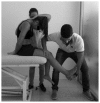Sciatic nerve stiffness is not changed immediately after a slump neurodynamics technique
- PMID: 29387655
- PMCID: PMC5774935
- DOI: 10.11138/mltj/2017.7.3.583
Sciatic nerve stiffness is not changed immediately after a slump neurodynamics technique
Abstract
Background: Neurodynamics techniques aim to assess and improve neural mechanosensitivity. However, there is no in vivo evidence regarding the mechanical effects of these techniques in the nerve stiffness. This study examined the immediate effects of a slump neurodynamics technique in the sciatic nerve shear wave velocity (SWV. i.e. an index of stiffness) using ultrasound-based elastography.
Methods: Fourteen healthy participants were included in this experiment. Sciatic SWV and ankle passive torque were measured during a passive ankle dorsiflexion motion (2°/s), before and immediately after 3 minutes of slump neurodynamics technique, randomly applied to one lower limb. The contralateral limb served as control.
Results: The slump intervention did not change the sciatic SWV (P=0.78), nor the dorsiflexion passive torque (P=0.14), throughout the ankle dorsiflexion motion. Excellent values of intra-rater repeatability (ICC=0.88, 0.68-0.96), and low values of standard error of measurement (0.59 m/s, 0.35-1.15m/s), were observed for the SWV measurements.
Conclusions: The sciatic nerve stiffness of healthy participants did not change immediately after a slump neurodynamics technique, suggesting a compliance of the neural tissue to tensile loads. However, these results ought to be confirmed using other neurodynamics techniques and in other populations (e.g. peripheral neuropathies).
Level of evidence: III.
Keywords: elastography; nerve biomechanics; shear wave velocity.
Conflict of interest statement
Conflict of interest None to declare.
Figures



Similar articles
-
Shear Wave Elastographic Investigation of the Immediate Effects of Slump Neurodynamics in People With Sciatica.J Ultrasound Med. 2020 Apr;39(4):675-681. doi: 10.1002/jum.15144. Epub 2019 Oct 21. J Ultrasound Med. 2020. PMID: 31633231
-
Non-invasive assessment of sciatic nerve stiffness during human ankle motion using ultrasound shear wave elastography.J Biomech. 2016 Feb 8;49(3):326-31. doi: 10.1016/j.jbiomech.2015.12.017. Epub 2015 Dec 18. J Biomech. 2016. PMID: 26725218
-
Chronic effects of muscle and nerve-directed stretching on tissue mechanics.J Appl Physiol (1985). 2020 Nov 1;129(5):1011-1023. doi: 10.1152/japplphysiol.00239.2019. Epub 2020 Aug 27. J Appl Physiol (1985). 2020. PMID: 32853116 Clinical Trial.
-
Noninvasive Measurement of Sciatic Nerve Stiffness in Patients With Chronic Low Back Related Leg Pain Using Shear Wave Elastography.J Ultrasound Med. 2019 Jan;38(1):157-164. doi: 10.1002/jum.14679. Epub 2018 May 6. J Ultrasound Med. 2019. PMID: 29732595
-
In Vivo Effects of Joint Movement on Nerve Mechanical Properties Assessed with Shear-Wave Elastography: A Systematic Review and Meta-Analysis.Diagnostics (Basel). 2024 Feb 5;14(3):343. doi: 10.3390/diagnostics14030343. Diagnostics (Basel). 2024. PMID: 38337859 Free PMC article. Review.
Cited by
-
Neurodynamics: is tension contentious?J Man Manip Ther. 2022 Feb;30(1):3-12. doi: 10.1080/10669817.2021.2001736. Epub 2021 Nov 16. J Man Manip Ther. 2022. PMID: 34781843 Free PMC article.
-
Using ultrasound shear wave elastography to characterize peripheral nerve mechanics: a systematic review on the normative reference values in healthy individuals.Ultrasonography. 2024 May;43(3):169-178. doi: 10.14366/usg.23211. Epub 2024 Feb 14. Ultrasonography. 2024. PMID: 38544459 Free PMC article.
-
Quantitative Ultrasound Techniques Used for Peripheral Nerve Assessment.Diagnostics (Basel). 2023 Mar 2;13(5):956. doi: 10.3390/diagnostics13050956. Diagnostics (Basel). 2023. PMID: 36900101 Free PMC article. Review.
-
Mechanical Effects of a Specific Neurodynamic Mobilization of the Superficial Fibular Nerve: A Cadaveric Study.J Athl Train. 2023 May 1;58(5):445-451. doi: 10.4085/1062-6050-0154.22. J Athl Train. 2023. PMID: 35834709 Free PMC article.
-
Shear Wave Elastography of the Sciatic Nerve and Its Relationship with Posterior Chain Flexibility in Healthy Participants: An Observational Study.Sensors (Basel). 2025 May 2;25(9):2885. doi: 10.3390/s25092885. Sensors (Basel). 2025. PMID: 40363321 Free PMC article.
References
-
- Maitland GD. Negative disc exploration: positive canal signs. Aust J Physiother. 1979 Jul;25(3):129–34. - PubMed
-
- Butler DS. The Sensitive Nervous System. Vol. 431 Noigroup Publications; 2000.
-
- Boyd BS, Topp KS, Coppieters MW. Impact of movement sequencing on sciatic and tibial nerve strain and excursion during the straight leg raise test in embalmed cadavers. J Orthop Sports Phys Ther. 2013 Jun;43(6):398–403. - PubMed
-
- Ellis RF, Hing WA, McNair PJ. Comparison of longitudinal sciatic nerve movement with different mobilization exercises: an in vivo study utilizing ultrasound imaging. J Orthop Sports Phys Ther. 2012 Aug;42(8):667–675. - PubMed
LinkOut - more resources
Full Text Sources
Other Literature Sources
